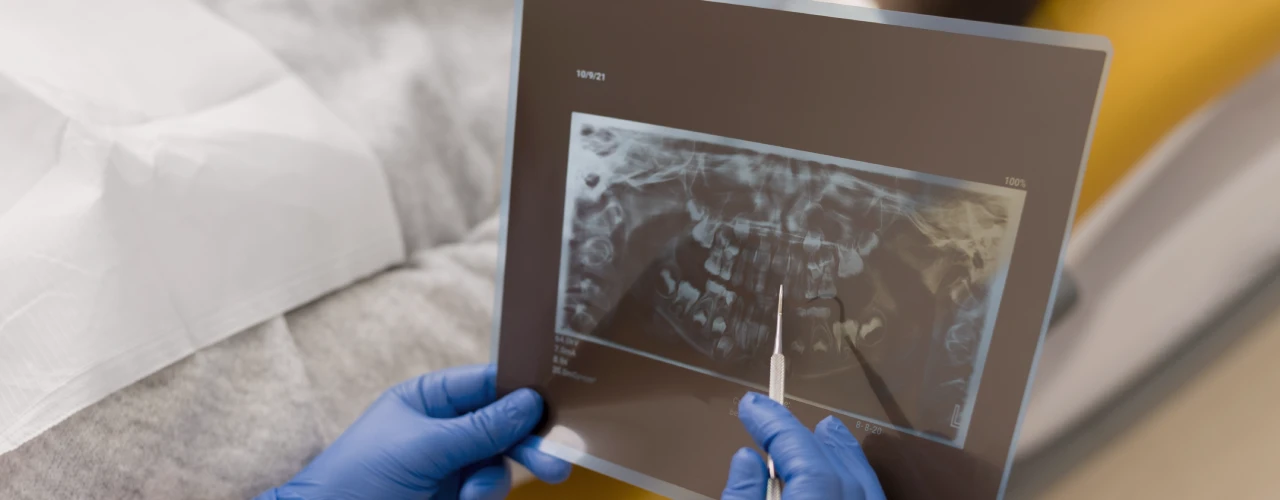Dental X-rays, also known as radiographs, play a crucial role in the diagnosis, treatment planning, and monitoring of oral health conditions. They provide valuable information not visible during a regular dental exam, allowing dentists to detect and address dental issues early before they become more serious.
Types of Dental Tooth X-Rays
- Bitewing X-rays: A bitewing X-ray examines one specific area of your mouth. They are usually used to detect cavities and assess the health of the bone supporting the teeth.
- Periapical X-rays: They capture the whole tooth. It shows everything from the crown to the root. They diagnose issues such as infections or abnormalities in the tooth root.
- Full Mouth Survey X-ray: A full mouth survey X-ray is a series of individual images that combines bitewing and periapical images. These X-rays are usually taken when your dentist suspects jaw cysts or tumours. They are also used for dental work such as root canals, extractions and gum diseases.
- Panoramic X-rays: Panoramic X-rays are like panoramic photos. They are used to take images of your entire mouth. It shows the position of fully emerged, emerging and impacted teeth, all in one image.
- Occlusal X-rays: Occlusal X-rays help track the development and placement of a section or an entire arch of teeth in the upper or lower jaw. Pediatric dentists mostly use them to find children’s teeth in the upper or lower jaw that have not yet broken through the gums.
Who Can Benefit from Digital Dental X-Rays?
- Routine Check-Ups: In most cases, regular dental exams will require digital X-rays. This becomes very important in monitoring dental health and identifying any issues early.
- Orthodontic Patients: Those undertaking orthodontic procedures with braces or aligners need precise X-rays to plan the treatment and track its progress.
- TMJ Disorders: Patients with TMJ disorders need an imaging modality to diagnose, which is the pathological condition or management policy. Read more about our TMJ Treatment in Wadala.
- Dental Implants and Surgeries: Planning for dental implant placements and other oral surgeries mandates accurate X-rays.
- Children: An X-ray examination is needed to monitor their dental and jaw developmental stages.
Why Are Digital Dental X-Rays Better?
- Better images: Digital X-rays produce better images for diagnosis and treatment planning.
- Reduced radiation exposure: Digital technology drastically reduces radiation as opposed to the old ways of taking X-rays, making it safer for patients.
- Instant results: One can have instant images from this process, hence quicker diagnosis and medication.
- Environmental friendliness: Digital X-rays do not involve chemicals in the processing stage and are more environmentally friendly.
- Better Storage and Sharing of Images: Digital images are easily stored, recovered, and shared with other health professionals if needed.
Why Should You Prefer The Smile Canvas for a Digital Dental X-Ray?
- Experienced Professionals: Our dentists in Wadala consist of highly professional dentists and technicians who ensure that the examination takes place accurately and comfortably.
- Cutting-Edge Technology: Our institution has advanced digital X-ray equipment, ensuring excellent diagnostic images.
- Patient-Centric Care: We focus entirely on your comfort and satisfaction by delivering personalised care.
Experience the benefits of digital dental X-rays at our clinic. Whether you need a routine check-up or specialised treatment, we are here to help. Contact us today to schedule an appointment and take the first step towards better oral health.
FAQs

Dr. Rishabh Pendurkar
Dr. Rishabh Pendurkar offers 16 years of clinical expertise, including his role as Consultant at the renowned Asian Heart Institute in Mumbai. Known for his precision and care, Dr. Pendurkar has successfully handled a wide spectrum of dental cases, from routine to complex treatments.


